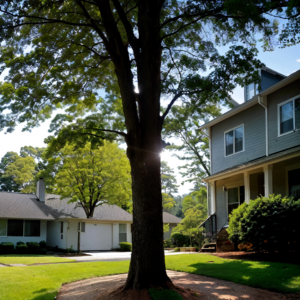
Fall fertilization will help keep your trees & plants healthy through the Winter & ready for Spring!
What is Fall Fertilization?
Fall fertilization is the process of adding nutrients to your trees and plants in the Fall so that they are protected and cared for throughout the Winter.
Fertilization during the Fall allows nutrients to be used for root growth, while the remaining is stored in the plant and will be ready for when growth starts in the Spring.
Why fertilize my trees this Fall?
Fall is a great time to replenish essential nutrients in the soil and keep your trees happy and healthy!
- Helps defend against environmental stresses
- Strengthens trees’ defenses against diseases and pests
- Encourages growth for healthier and more vibrant trees
- Enriches the soil to help promote a healthy ecosystem
Call our Certified Arborists at Mockingbird Tree today to evaluate your trees to see if it’s the best solution for you. Here are a few signs to look out for:
- Poor growth or thinning
- Discoloration of leaves (lighter green/anemic-looking)
- Smaller/stunted leaves
- Early color change or leaf drop
Please call a professional and don’t try this on your own! You can kill your tree by using too much fertilizer or mixing chemicals with improper ratios.
Request a free estimate today and we will send one of our Certified Arborists out to evaluate your trees and determine if a Fall fertilization is right for you.
How Fall Fertilizations can help!
Urban trees often suffer from nutrient deficiencies such as nitrogen, magnesium, and iron. Fertilizing is a great way to get nutrients back into the soil so your tree can thrive.
You should know that not all fertilizers are created equal. The Mockingbird Tree Care professionals can help you choose the fertilizer that is appropriate for your trees and plants, as well as our climate.
- There are different types of fertilizers available in the market, each with its own advantages and disadvantages.
- Generally, we use a nitrogen-based fertilizer that also contains phosphorus and potassium.
- Slow-release fertilizers are often best because a fast-release can cause a tree to grow too fast.
- We may perform a soil test to determine the PH of the soil and whether a fertilization is the right solution for your trees.
- Fertilizer can be applied any time from late September through early April
Keeping your trees and plants healthy protects them, which can help them be stronger and live longer. Call Mockingbird Tree today at 479-633-9876 for your Fall Fertilization needs! Or, you can request an estimate online.
Sources:
– Fertilizing Trees & Shrubs, College of Ag, Forestry and Life Sciences, Clemson University
– Fertilizing Shade Trees, University of Missouri- Extension
